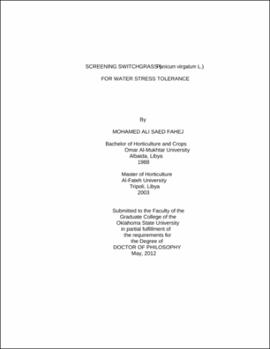| dc.contributor.advisor | Kakani, Gopal | |
| dc.contributor.author | Fahej, Mohamed Ali | |
| dc.date.accessioned | 2013-12-10T18:04:33Z | |
| dc.date.available | 2013-12-10T18:04:33Z | |
| dc.date.issued | 2012-05 | |
| dc.identifier.uri | https://hdl.handle.net/11244/7725 | |
| dc.description.abstract | Scope and Method of Study: Switchgrass can benefit from enhanced water stress tolerance as it will be grown in marginal areas. Whole plant and in vitro culture techniques can help to improve switchgrass biomass production and water stress tolerance. Identifying specific traits in switchgrass that contribute to water stress tolerance can provide useful information to breeders to increase productivity. The objectives of this study are (1) to evaluate growth and physiological parameters and identify switchgrass traits that can contribute to water stress tolerance and increased water use efficiency, (2) to study the effect of water stress at the cellular level using in vitro culture and identify cell lines that can survive water stress, and (3) to assess morpho-physiological traits of plants derived from water stress tolerant cell lines. Under Objective 1, 13 genotypes were screened using control (well watered - WW), 60%WW and 20%WW treatments, and growth and physiological traits, total biomass, and biomass components were measured. Under Objective 2, 12 genotypes were evaluated using an in vitro culture procedure to investigate callus formation. Two cultivars, Alamo and Forestburg, selected from Objective 1 and from the initial in vitro water stress screening were used to induce variation under water stress using MS media + Polyethylene glycol. For Objective 3, regenerated Alamo and Forestburg were compared to seed plants of the same cultivars. | |
| dc.description.abstract | Findings and Conclusions: The tested switchgrass cultivars differed in tolerance to water stress. In the greenhouse study, the effect of water stress on total biomass was genotype dependent. Alamo (lowland) and Forestburg (upland) were identified as most tolerant to water stress. Morphological traits such as stem elongation rate and total dry weight, and physiological traits such as stomatal conductance, transpiration and photosystem efficiency were identified to help rapidly screen switchgrass populations. The In vitro study identified 45 µM 2, 4-D + 45 M BA as the best combination of growth regulators for inducing callus formation in switchgrass. Results from in vitro studies revealed that both Alamo and Forestburg callus survived the stress induced and produced callus. Regenerated Alamo had better morpho-physiological traits and proline concentration compared to plants of regenerated Forestburg and seed plants of Alamo and Forestburg. In conclusion, whole plant screening can identify cultivars and traits for increased water stress tolerance and in vitro culture can be used to rapidly screen and improve switchgrass for abiotic stress tolerance. | |
| dc.format | application/pdf | |
| dc.language | en_US | |
| dc.rights | Copyright is held by the author who has granted the Oklahoma State University Library the non-exclusive right to share this material in its institutional repository. Contact Digital Library Services at lib-dls@okstate.edu or 405-744-9161 for the permission policy on the use, reproduction or distribution of this material. | |
| dc.title | Screening switchgrass (Panicum virgatum L.) for water stress tolerance | |
| dc.contributor.committeeMember | Martin, Bjorn | |
| dc.contributor.committeeMember | Wu, Yanqi | |
| dc.contributor.committeeMember | Yan, Liuling | |
| dc.contributor.committeeMember | Cole, Janet C. | |
| osu.filename | Fahej_okstate_0664D_12163.pdf | |
| osu.accesstype | Open Access | |
| dc.type.genre | Dissertation | |
| dc.type.material | Text | |
| dc.subject.keywords | in vitro culture | |
| dc.subject.keywords | switchgrass | |
| dc.subject.keywords | water stress | |
| thesis.degree.discipline | Plant and Soil Sciences | |
| thesis.degree.grantor | Oklahoma State University | |
